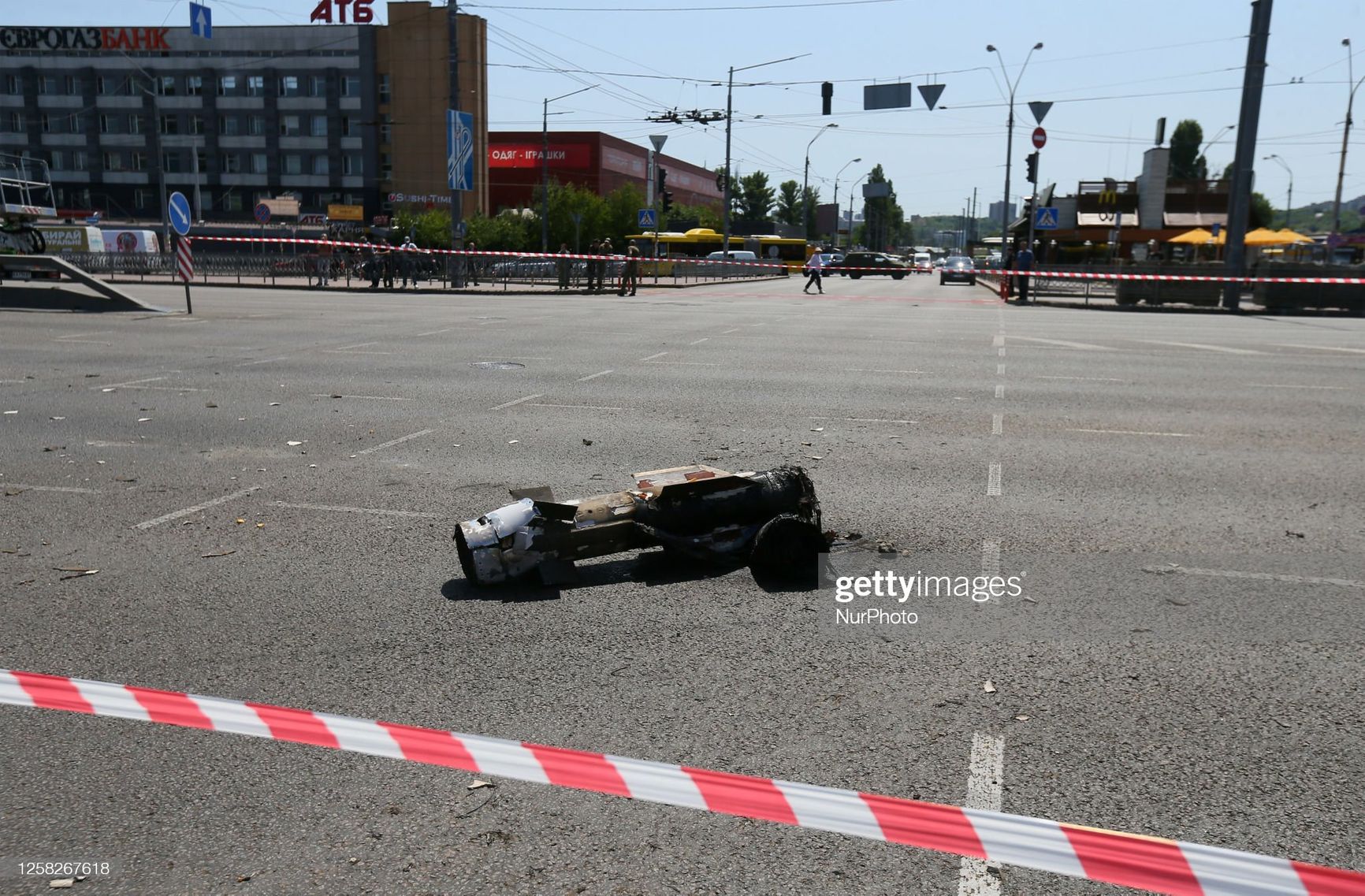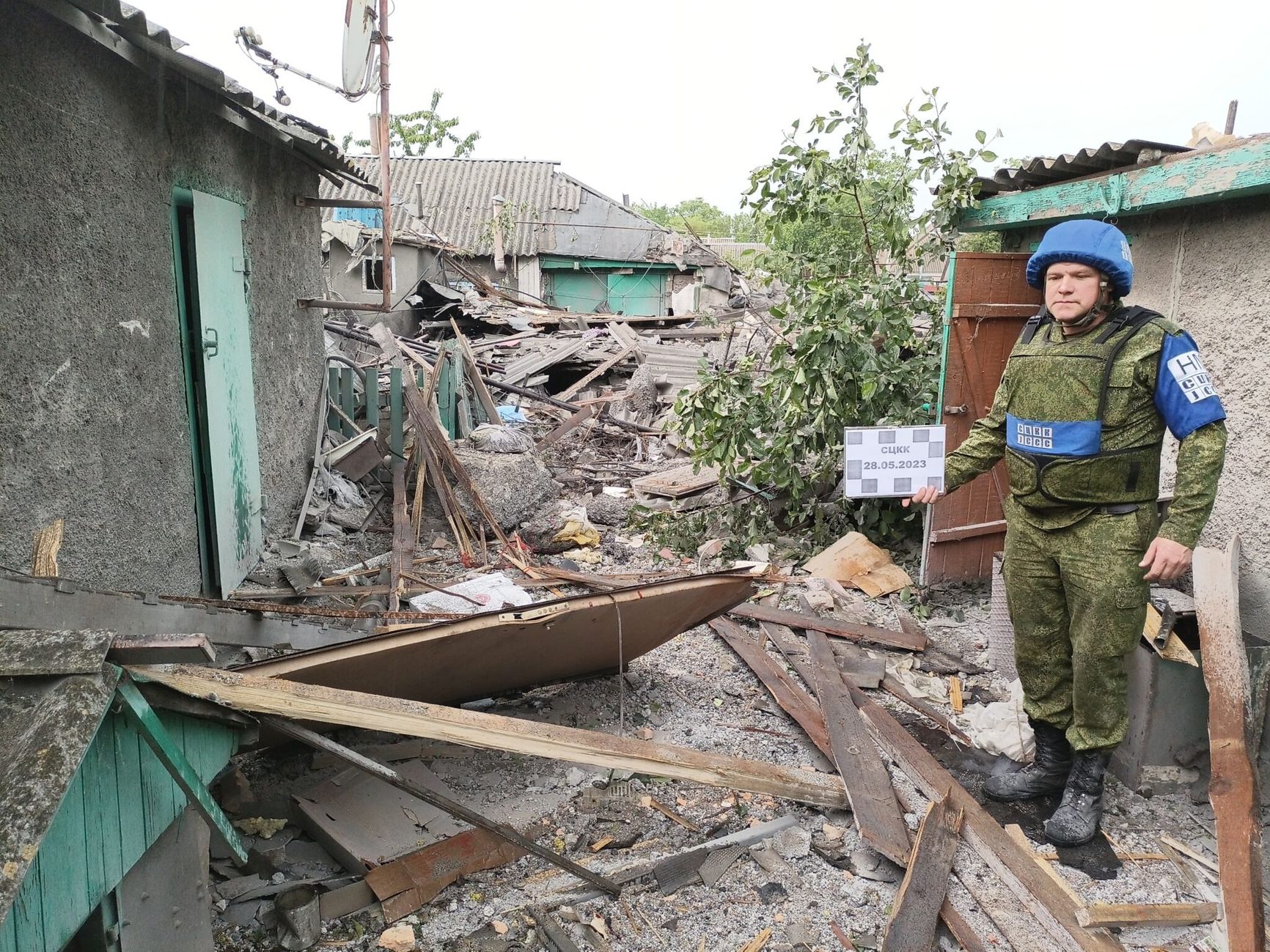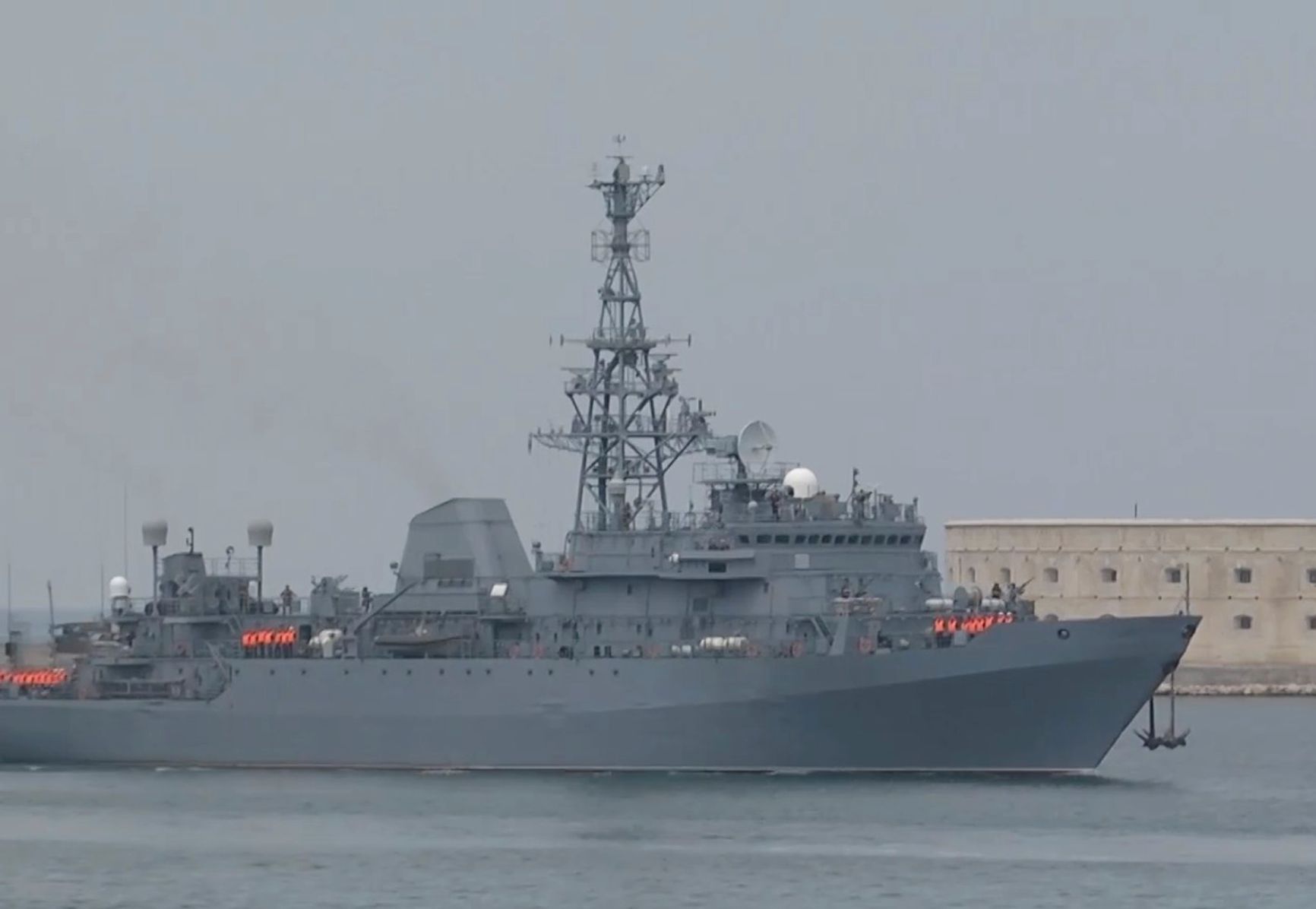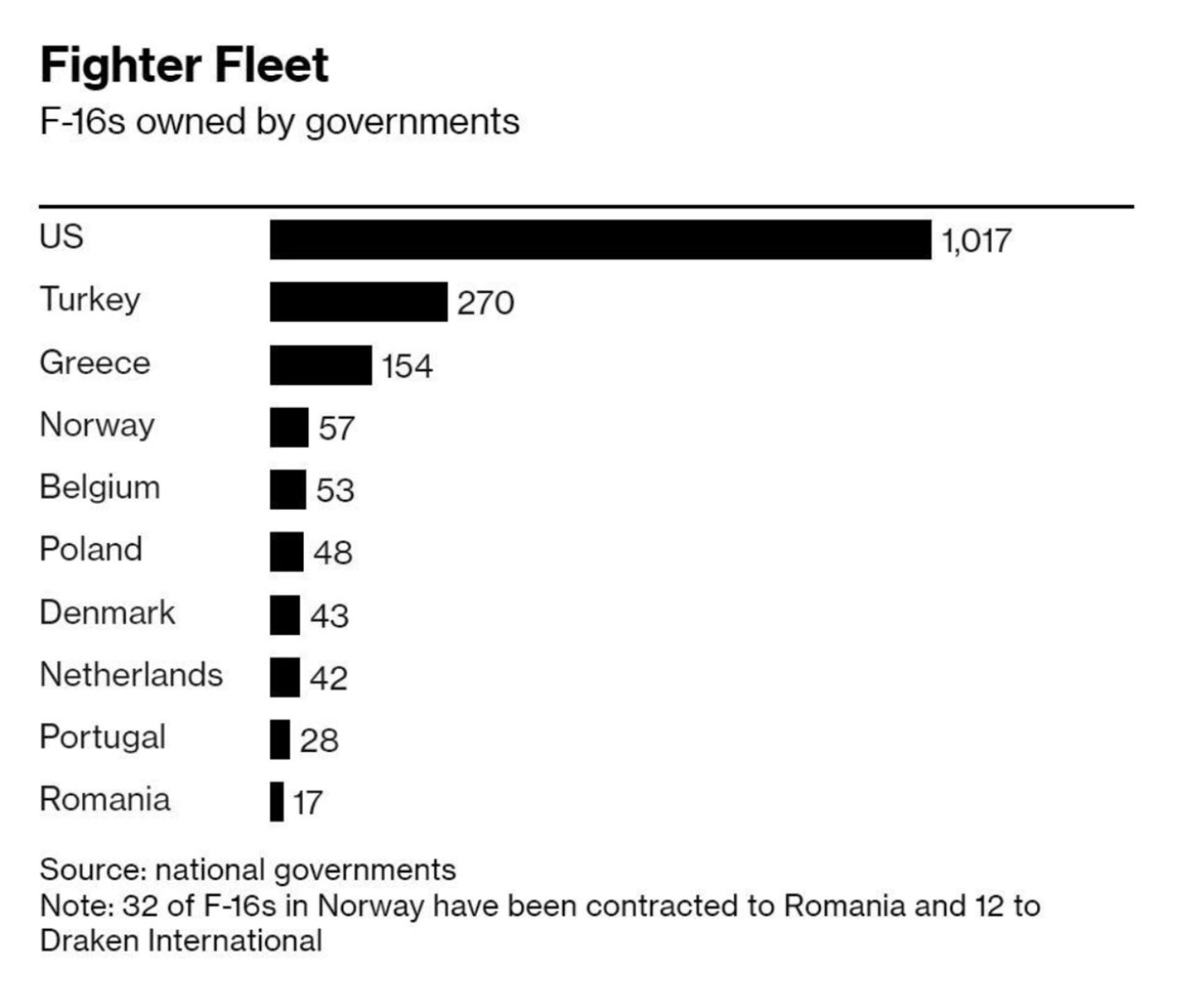
In today's summary:
- The front lines are experiencing a lull, but Russian forces are nonetheless trying to advance in unusual directions;
- Over 90 Shahed-type kamikaze drones were launched at Ukraine over the past two days;
- Large-scale ballistic and cruise missile attacks on Kyiv;
- Russia attacked a military airfield near Khmelnytskyi, five aircraft were damaged;
- The Armed Forces of Ukraine (AFU) struck Russian military bases near Mariupol with long-range missiles;
- Exhaustive evidence emerged that the ship “Ivan Khurs” is intact and unharmed;
- The well-known OSINT project Oryx reported that over 2,000 Russian tanks have been lost in combat;
- 400 Ukrainian servicemen are being trained on American M1 Abrams tanks.
The front line
The AFU General Staff’s daily report noted the attempts of Russian forces to attack in “unusual directions.” Attacks were recorded in the area of Velyka Novosilka, a village to the west of Vuhledar.
A lull on the front is being observed – Ukraine's Deputy Minister of Defense Hanna Maliar reported a significant decrease in activity in the Bakhmut direction.
The Ukrainian OSINT project DeepState published a video of AFU artillery strikes on the MiG-17 monument area of Bakhmut – the last stronghold of Ukrainian troops in the city. The observation led the Conflict Intelligence Team (CIT) to conclude that the AFU has completely abandoned the city.
According to British military intelligence, the Wagner PMC is indeed withdrawing from Bakhmut “from some positions” that units from the so-called “DPR” have begun to occupy. UK intelligence also believes that the 31st Brigade of the Russian Airborne Troops has been sent to strengthen the flanks near Bakhmut.
On the morning of May 27, a motivational video was published on the Telegram channel of Ukrainian Armed Forces Commander-in-Chief Valerii Zaluzhnyi, accompanied by the caption: “It's time to take back what belongs to us.” Multiple commentators saw the video as the announcement of the Ukrainian army’s much-awaited counteroffensive.
Shelling and sabotage
The AFU’s Air Force Command reported that on the night of May 28, Russia launched 54 Shahed-type (aka Geran) kamikaze drones at Ukraine, marking the largest attack since the start of the war. 52 of the drones were reportedly intercepted. Later, the AFU General Staff clarified that a total of 59 Shahed drones were launched, of which 58 were shot down.
The Russian Defense Ministry called these actions “a group strike with long-range precision airborne weapons” in its daily report. As usual, the ministry reports the destruction of “all targets,” which are said to be targets at airfields.
The AFU’s Center Air Command reported that critical infrastructure, as well as Ukrainian military facilities in the country’s central regions, were the main targets of the attack. The Center Command’s anti-aircraft missile forces destroyed 37 Shahed drones, while another 8 kamikaze drones were intercepted by the AFU Ground Forces’ air defenses.
Massive long-range attacks continued on the night of May 29. According to the AFU’s Air Force Command, 40 Kh-101/555 missiles were launched from Tu-95MS strategic bombers from the Caspian Sea area, along with 35 Shahed kamikaze drones. The report claimed that the AFU managed to shoot down 37 cruise missiles and 29 Shaheds.
In Kyiv, over 40 air targets were identified and destroyed by the city’s air defense forces, according to the Kyiv City Military Administration (KMVA). Multiple people were killed and injured, and several buildings were damaged as a result of falling kamikaze drone debris.
In the afternoon, Kyiv came under fire again. This time, according to a report from the AFU General Staff, 11 Iskander-K and Iskander-M cruise and ballistic missiles were fired at the Ukrainian capital. All targets were shot down by air defense forces – AFU Air Force spokesman Yurii Ihnat said that the missiles were brought down by an American Patriot SAM (surface-to-air) missile system. The KMVA noted a change in tactics by the Russians: “After a long period of exclusively nighttime attacks, a strike was launched against a peaceful city in the daytime, when most residents were at work and on the streets.”
As a result, debris from six aerial targets and anti-air missiles fell on Kyiv. Three pieces of debris fell on the Obolonsky district – on a gas station, a road, and on a park area. Debris fell on a road in the Dniprovsky district, and also came down in a park in the Desnianskyi district. Judging by the look of one of the pieces of debris, one can conclude that PAC-3 CRI MIM-104 Patriot interceptor missiles were used.
Ironically, the debris fell not far from a McDonalds restaurant just a few days after a video posted by former Ukrainian Economy Minister Tymofiy Mylovanov showing the operation of another McDonalds in Kyiv sparked a heated discussion on Twitter – critics claimed that there really was no war in Ukraine and that US taxpayer money (including funds for Patriot systems) was being wasted.

Law enforcement in Kyiv is actively working with citizens recording the operation of the city’s air defense systems. Two “amateur photographers” have been reportedly detained – one in the Sviatoshynskyi district, while the other was detained in his car on Ushakov Street.
Local authorities in the Khmelnytskyi region confirmed a hit on a military facility and the disabling of five aircraft. Government agencies were reportedly working to contain fires at fuel and lubricant depots, salvage materiel and repair the runway. Russian pro-war channels wrote that Ukrainian MiG-29s and Su-24s might have been stationed at the Starokostiantyniv Air Base. Yurii Ihnat confirmed the strike on the airfield, acknowledged “some damage” and said he could not disclose all the details. However, according to Ihnat, “everything will be restored and everything will work.”
Ukraine’s 7th Tactical Aviation Brigade is notably based at Starokostiantyniv – the unit is home to the Su-24MR tactical bomber, which was recently confirmed as a carrier of UK-supplied Storm Shadow missiles. A picture of the bomber was shown on a postcard during a recent meeting between Ukrainian Defense Minister Oleksii Reznikov and his British counterpart Ben Wallace. However, it is currently unknown whether the British missiles were at the airfield at the time of the strike or whether they were damaged.

After a drone attack in Zhytomyr, the local city council reported damage to at least 26 homes, as well as educational and medical institutions. Vitaly Bunechko, the head of the Zhytomyr Regional Military Administration (OVA), earlier reported strikes on local infrastructure.
In the Kharkiv region, Russia struck the village of Kivsharivka – according to preliminary information, an Iskander missile was used in the attack. A dormitory, two private buildings, and a gas pipeline were damaged as a result of the blast. Seven people were wounded, including two children aged 10 and 14. The village of Glushkivka in the Kupiansk district was also reportedly shelled.
In the Donetsk region, Russian forces dropped FAB-250 air bombs on the town of Toretsk, with one of them hitting a gas station, killing one person and wounding nine others. There were also reports of damage to vehicles, an administrative building, a bank building, and one of the town's educational institutions.
In Dnipro, local authorities completed the removal of debris from a hospital that was destroyed after a Russian missile strike. Two people were killed, 32 were injured, 15 of them remain in hospitals, with 5 in serious condition. Three people were declared missing, but the head of the Dnipropetrovsk Regional Military Administration (OVA), Serhiy Lysak, soon announced that they had been declared dead after receiving the results of the examination of body fragments.
In the Dnipropetrovsk region, the Pokrovske settlement in the Synelnykove district was shelled. One person was killed, and nine others were wounded, including a child. Two homes were destroyed, and about 30 others were damaged.
The Mariupol City Council (formed before the occupation of the city by the Russian Armed Forces) reported strikes on Russian army depots and bases in Yurievka, Nikolske and Urzuf. The body recalled that the Mariupol district had been considered to be “in the rear” until recently and noted that “the situation is changing.”
Petro Andryushchenko, an adviser to the Ukrainian mayor of Mariupol, named tentative casualty figures among the Russian military. According to the official, about 100 people were killed and about 400 more were hospitalized with wounds. A communications and electronic warfare station was also reportedly destroyed.
On Sunday, the Ukrainian City Military Administration (GVA) of occupied Berdyansk reported five strikes on Russian positions near the city and noted the ineffectiveness of Russian air defenses. On its part, the Ukrainska Pravda newspaper reported one hit near the village of Andrivka, three explosions near the village of Novotroitske, as well as near Berdyansk airport.
Most likely, British Storm Shadow cruise missiles with a range of more than 250 kilometers were used in the attacks. On May 28, Ukrainian Defense Minister Oleksii Reznikov claimed that all Storm Shadow missiles used previously had successfully hit their targets.
The so-called “LPR” representative office in the Joint Center for Control and Coordination reported the shelling of the town of Almazna near Kadiivka. Three civilians were reportedly killed, one home was destroyed, and seven more were damaged, as well as power lines and a gas pipeline.

Recently, the geography and range of use of Ukrainian drones has expanded significantly. Incidents involving drones were recorded in Russia’s Pskov and Tver Regions.
On the morning of May 27, two UAVs attacked an administrative building in the village of Litvinovo in the Pskov region, which is located near an oil pipeline. The drones’ target was reportedly a Transneft oil pumping station. No casualties were reported as a result of the strike, although the facades of several buildings were damaged and windows broken.
Two UAVs attacked the Andreapol oil pumping station, which services the “Druzhba” oil pipeline, near the village of Yerokhino in the Tver region on May 27. One drone exploded, damaging the roof of the oil depot building, while the other crashed into the ground and detonated. The resulting fire was extinguished.
A new attempt to strike the Ilsky Oil Refinery with drones took place in the Krasnodar region, slightly damaging a diesel fuel plant.
In the Bryansk region, a drone hit a Russian Defense Ministry vehicle between Brovnichi and Sushany on May 27, killing two servicemen.
A defense line came under fire near the village of Plekhovo in the Kursk region on the same day, killing a construction worker.
In the Belgorod region, the town of Shebekino was systematically shelled for several days in a row. An industrial zone and an electrical substation were targeted.
The news group of Russian government TV channel Perviy Kanal (“Channel One”) on social network VK tried to ban comments mentioning Shebekino, which regularly comes under fire, causing a Streisand effect. Regional social media groups responded by writing the name of the settlement with deliberate mistakes in the comments, or using the Latin alphabet. Comments about Shebekino began to multiply in the TV channel’s main group as well.
Vyacheslav Gladkov, the governor of the Belgorod region, suggested “annexing Kharkiv to the Belgorod region” as a radical solution to the shelling. He also said that Ukrainian “sabotage groups” had infiltrated the region at least six times since the beginning of the war.
Vladimir Kulishov, head of the FSB Border Guard Service, reported that over 2,000 attacks on military, border, transport and energy infrastructure facilities in the Russian border area, including the use of drones, had been recorded from the territory of Ukraine since February 2022.
Losses
The BBC's Russian Service, together with independent outlet Mediazona, updated its count of Russian casualties in the war against Ukraine based on 24,005 obituaries available in open sources. One third of the dead were listed as volunteers, mobilized soldiers, prisoners and new recruits in private military companies (PMCs), indicating they were not related to Russia’s army prior to February 24, 2022. The media outlets noted that the actual number of deaths is much higher than the stated figure of confirmed deaths.
Media outlets linked to the Wagner PMC, such as the Telegram channel Grey Zone, published their own data on the losses inflicted on Ukraine. The channel alleged that between March 2022 and May 2023, the Wagner Group killed 72,095 Ukrainian soldiers, captured 509 people, destroyed more than 2,000 motor vehicles and over 1,000 armored vehicles.
The apparent mass desertion of convicts recruited to a Russian Ministry of Defense unit, previously reported by “war correspondent” Roman Romanov, has been confirmed. The regional media outlet 161.ru wrote that an orientation note was sent out in the Rostov region listing 39 former convicts who had run away from the “Storm Z” detachment along with their weapons. According to the publication, they killed a military officer from the so-called “LPR” security ministry during their escape.
Russian state-run news agency TASS then reported the escape of seven more former prisoners from a military unit near occupied Soledar in the Donetsk region. According to a source in law enforcement, five of them were detained, the sixth was killed by his fellow soldiers for wanting to surrender, and there has been no information on the whereabouts of the seventh deserter.
The controversy over the fate of the Yuriy Ivanov class (Project 18280) medium reconnaissance ship Ivan Khurs after the attack by several naval drones appears to have come to an end. The Russian Defense Ministry posted a video of the ship's arrival and ceremonial welcome in Sevastopol, with no visible damage on the hull or elsewhere.

Naval researcher H I Sutton believes that the problem with Ukrainian maritime drones is in the regular failure of their warheads, which might be caused by design flaws of early models. However, he believes the concept itself is quite viable.
The Russian Defense Ministry has confirmed the incident with the Russian Su-25 ground attack jet attacked by MANPADS. According to the ministry, the pilot managed to fly the damaged plane to the nearest airport and make a landing.
An obituary for Major Ilya Ortikov, who was allegedly killed on May 25 in a strike on a Russian military HQ in Berdyansk, appeared on social media. The photo shows Ortikov with a chevron similar to the emblem of the 58th Army of the Southern Military District, which is currently occupying positions in the Zaporizhzhia direction. It is possible that the strike on Berdyansk hit the headquarters of the formaton. The city is notably over 90 kilometers away from the line of contact, which suggests that the strike was carried out by a Storm Shadow air-launched cruise missile.

The OSINT project Oryx counted more than 2,000 lost Russian tanks confirmed by visual evidence. Oryx estimated the total confirmed losses of Russian army equipment at 10,469 units.
Arms supplies
US congressmen are trying to get the Biden administration to hand over ATACMS long-range missiles to Ukraine. According to a letter obtained by Foreign Policy, the leaders of the bipartisan Helsinki Commission urged President Biden to give the AFU the missiles after he made a decision on the delivery of F-16 fighters to Ukraine. The commission believes the arms will help “ensure a complete victory.” The letter also noted that “virtually all of the weapons systems that Ukraine requested were provided only after pressure [on the administration - The Insider].”
The German Defense Ministry confirmed receiving a request from Ukraine for the transfer of Taurus long-range missiles. They are capable of flying distances of up to 500 km, as well as resisting interference created by the enemy, thanks to four independent navigation systems. The details of the request were not disclosed.
The Netherlands has not yet made a decision whether it will transfer its F-16 fighter jets to Ukraine. Prime Minister Mark Rutte said that the decision on this has not been made yet and depends on the consent of Washington. In turn, the White House said that it would not prevent third countries from supplying these aircraft to Ukraine. Earlier, the Netherlands and the UK announced the creation of a coalition of countries to supply the F-16s to Ukraine.

The New York Times reported on the start of training of 400 Ukrainian service members on US-made M1A2 Abrams tanks in Germany. About 200 servicemen are being trained to operate the tanks, while the rest are being trained in maintenance.
Neutral Austria has agreed to donate 2 million euros worth of demining equipment to Ukraine. Reports have confirmed that the transfer was agreed “after a fierce debate” in the Austrian government. Austrian Chancellor Karl Nehammer emphasized that “not a single Austrian soldier” would set foot on Ukrainian soil as long as there is war in Ukraine.
In an earlier summary, The Insider reported on a remarkable video in which a British Challenger 2 tank practiced over concrete barriers and engineering obstacles, and interpreted it as belonging to the AFU. The tank in fact belongs to a British military unit, and the video was shot at a training ground in Estonia.
Australia is working on a military assistance package for Ukraine in a joint effort with the US. Ukrainian Defense Minister Oleksii Reznikov asked this country to join the “tank coalition” and also to transfer Hawkei armored vehicles to the AFU.
The pro-Russian Telegram channel Military Informer (“Voenniy Osvedomitel”), based on a report from the administration of the town of New York in the Donetsk region, suggested that the Russian Armed Forces have begun using FAB-250 air bombs with gliding and correction modules (UMPK). The use of these modules has so far only been confirmed with the larger FAB-500 bombs, with the total weight of the complex often causing the bombs to fall out of aircraft. On the other hand, the impact radius of the FAB-250, when detonated, is much smaller, which can be quite critical, since the supposedly high-precision aerial bombs are often not that accurate.